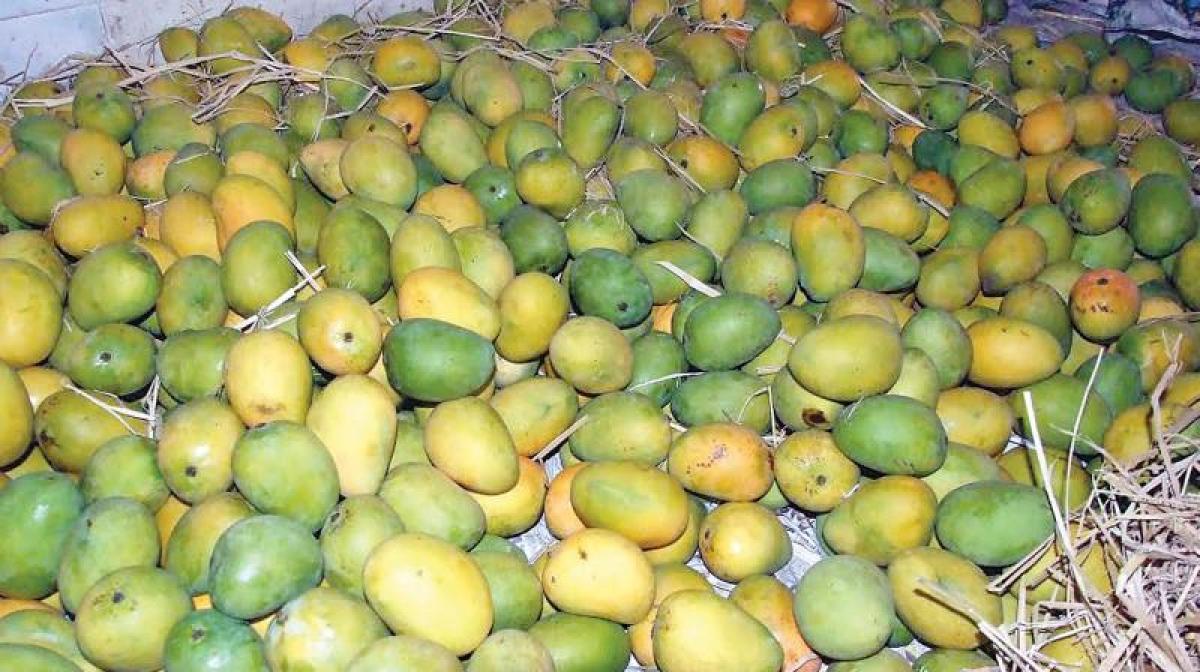Live
- Educational Trips in South Kanara Put on Hold Following Murudeshwar Drowning Incident
- Karnataka Temple Embraces Mechanical Elephant for Cruelty-Free Ceremonies
- Temple modelled after Ram Mandir to be constructed in US
- Property dealer shot dead in broad daylight in Ranchi
- Maharashtra: CM Fadnavis expands Cabinet; inducts 39 ministers
- Winter Session of UP Assembly from Dec 16; CM seeks cooperation of all parties
- AIADMK executive council meet passes sixteen resolutions, vows to make Edappadi CM again
- Manchu Family Feud Resurfaces in Jalpally
- Kerala Hindu leader gifts Rig Veda to Pope Francis
- 35 miners trapped under rubble in Afghanistan
Just In

The succulent Banaganapalle mango has got Geographical Indication (GI) registration from the Geographical Indications Registry here today.
The succulent Banaganapalle mango has got Geographical Indication (GI) registration from the Geographical Indications Registry here today.
The Registrar of Geographical Indications Registry, Chennai, O P Gupta accorded the registration following an application from Horticulture Commissioner, Andhra Pradesh.
The Andhra Pradesh government is the registered proprietor of the GI tag for mangoes, often hailed as "the king of fruits."
A GI tag indicates that the product comes from a specific region.
Banganapalle mangoes are renowned for its sweetness and have been grown for over 100 years in the state. It also known as Beneshan, Baneshan, Benishan, Chappatai and Safeda.
Besides, they are also called Banaganapalli, Banginapalli, Banaganapalle.
The fruits could retain their quality under cold storage even up to three months, Andhra Pradesh government said in documents seeking GI.
"The prominent characteristic of Banganapalle mangoes is that their skin has very light spots, stone is oblong in shape and having very thin seed with sparse and soft fibre all over," it said.
The primary centre of origin of the fruit is Kurnool district comprising Banaganapalle, Paanyam and Nandyal mandals, according to Andhra Pradesh government which mentioned Rayalaseema and coastal Andhra as secondary centres of origin.
The government has also listed Khammam, Mahabubnagar, Rangareddy, Medak and Adilabad districts in Telangana as secondary centres of origin.
Submitting documents for proof of origin, it also cited historical records like a "war fund seal (Banganapally-State Madras War Fund Seal)."
A logo too is in place which features a bright yellow fruit around which the tagline says "Banganappalle Mangoes of Andhra Pradesh," with images of a man and a woman appearing to be farmers.
According to an affidavit furnished in 2011 by the then Andhra Pradesh Commissioner of Horticulture, I Rani Kumudini nearly 7.68 lakh families, were involved in the production of Banaganapalle mangoes.
About 5,500 tonnes of Banganappalle variety of mangoes were being exported annually to countries like the US and UK.
While the annual turnover of Banaganapalle mangoes was approximately Rs 1,461 crore, exports were to the tune of Rs 20.68 crore, she had said.
GI is covered under the Intellectual Property Rights and the Trade Related Aspects of Intellectual Property Rights.
A GI tag certifies the origin of a product or produce from a particular region as the quality or other features of the product is attributable only to the place of its origin.
The tag helps farmers or manufacturers as the case may be to get a better price in the market.

© 2024 Hyderabad Media House Limited/The Hans India. All rights reserved. Powered by hocalwire.com







